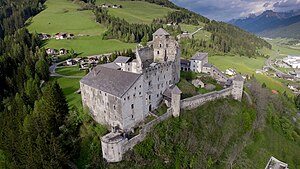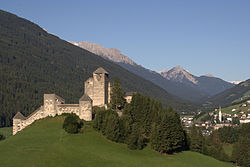Heinfels Castle
| Heinfels Castle | ||
|---|---|---|
|
Heinfels Castle in Panzendorf |
||
| Castle type : | Hilltop castle | |
| Conservation status: | essential parts received | |
| Standing position : | Ministeriale | |
| Place: | Heinfels | |
| Geographical location | 46 ° 45 '4.5 " N , 12 ° 26' 21.5" E | |
| Height: | 1130 m above sea level A. | |
|
|
||
Heinfels Castle is an extensive hilltop castle above Heinfels in East Tyrol . The strategically well-located weir system at 1130 m above sea level. A. provides a striking landmark of the Eastern Puster Valley . From the castle, one has a wide view out there up and drauabwärts and in the opposite opens Gailtal .
history
The legendary foundation by the Huns goes back to the 5th century. Until well into the 16th century, the castle was called "Huonenfels", "Huonifels", "Huenfels" or "Heunfels". However, today's historical research assumes that Heinfels was founded by the Avars . It is also considered likely that the castle had belonged to the Bavarian dukes since the 7th century .
In 1239, Otto Welf de Hunenvelse , who belonged to the older gentlemen of Welsperg , appeared for the first time , a ministerial named after the castle. The castle was first mentioned in a document in 1243 and was owned by the Freising ministerials.
In the 13th century, the Counts of Görz acquired Heinfels Castle through inheritance and, from 1275 onwards, expanded it into an important base, which was also the seat of a court. It is not known when the castle came into the possession of the Görz counts, but it was handed over to the latter in a contract of the same year between the two Görz Meinhard II and Albert I. According to this, the castle must have been in Gorizia's possession before.
In 1307 the castle, including its property and court, fell through an inheritance contract between Albert II and Heinrich III. to Albert. He shared his inheritance among his sons while he was still alive.
In 1460 Count Johann II of Gorizia lost the dispute over the inheritance of the Counts of Cilli against Emperor Friedrich III. In addition, he lost his Carinthian possessions and the Bruck residence through the Peace of Pusarnitz . He then moved to Heinfels and chose it as his future residence. In the following years he expanded the castle into a residential castle and built equally strong defenses.
When the last Count Leonhard from Gorizia died, the castle fell to the Habsburg Maximilian I on April 12, 1500 on the basis of an inheritance contract from 1394. He used it as a weapons and ammunition depot and had it expanded. A year later Maximilian pledged the castle due to financial worries to the Brixen bishop Melchior von Meckau , although this pledge had been denied during Count Leonhard's lifetime. In the meantime, however, the Görzischen captain and burgrave Virgil von Graben Heinfels had been transferred to administration for life, which now could not be reversed, especially since Von Graben played a major role in the entire transition process of the Görz inheritance into Habsburg hands. It was only after his death in 1507 that Virgil's son Lukas von Graben zum Stein , who had been entrusted with the administration of Heinfels, was asked on February 24, 1508 to cede the castle, court and office of Heinfels with all affiliations to the Bishop of Brixen, at the same time all subjects became Obedience to the Prince-Bishop requested.
Due to the ongoing Venetian conflicts and the threat from the Turks, the castle was constantly repaired and modernized. The population usually had to pay the costs. As a result, there were peasant revolts . In 1525 the castle was temporarily occupied by the farmers. A year later, on July 7th, 1526, the Burgmannen were able to repel another siege by a 2000-man peasant army under the leadership of Michael Gaismair .
In 1570, the Tyrolean Prince Archduke Ferdinand II redeemed the pledge for Heinfels Castle. However, in 1581 he had to pledge the possessions back to the diocese of Brixen and the then Bishop Johann Thomas von Spaur.
In 1593 there was major construction work that largely gave the castle its current appearance.
In 1612 Archduke Maximilian III. , called the Deutschmeister , took out the pledged Heinfels rule and handed it over to Engelhard Dietrich von Wolkenstein-Trostburg . In a major fire on January 15, 1613, large parts of the castle were completely destroyed. Soon afterwards the castle was rebuilt by the court chamber and the fortifications were expanded due to the persistent Venetian threat.
Archduke Leopold V bought the property back in 1629, but immediately pledged it to Hall Abbey. After the bankruptcy of the pledges, the royal women's monastery in Hall took over the castle in the same year. At first they only took over the lien, but in 1654 they bought Heinfels. During this time, the state of the castle deteriorated rapidly. An earthquake in 1714 caused further serious damage to the castle.
In 1783, Emperor Joseph II dissolved the women's monastery, which meant that the entire property, including Heinfels, fell to the state. 50 years later, the vacant castle was sold to the municipalities of the Sillian judicial district , with the exception of Innichen . In the meantime, the building was leased to Baron Ertl from Graz .
In 1880, however, a company of Tyrolean Kaiserjäger moved into Heinfels. They used the castle as a barracks until 1910 , which seriously affected it. As a result, in the snowy winter of 1917, the roof of the Romanesque residential tower collapsed. In 1932, the western gable wall of the residential tower finally collapsed. The chapel bay window and the stair tower were badly damaged.
Four years later, in 1936, Heinfels Castle was auctioned off to the market town of Sillian. In the same year, they sold the castle on August 26th to the local businessman Alois Stallbaumer. With his financial means he tried to protect the castle from further deterioration. In his will he bequeathed the castle to the Jesuit college in Innsbruck in 1974 . In 1977 the Viennese lawyer Dr. Max Villgrattner.
1999 extensive restorations were carried out to give the wide battlements of the keep a new hip roof put on.
In 2005, after Villgrattner's death, his daughter sold the castle to the Loacker family . The Loacker family runs a confectionery factory in Heinfels. The parties have agreed not to disclose the purchase price.
Building
Heinfels Castle consists of three assemblies. The oldest part dates from the 13th century and was built on the cliff as a stronghold. To the west of the keep are several buildings from the end of the 15th and the beginning of the 16th century. Together these form the courtyard. There was a cistern in the middle of the castle courtyard , which was described as dilapidated as early as 1535.
The core of the medieval castle complex is the 20 meter high keep. To this was in the 13th century Palas grown. The southern part of this residential tower was built later. This is the chapel wing. This was adapted to the late Gothic style in the second half of the 15th century . This section of the castle has fallen into disrepair today.
The western core castle is still in a better state of preservation today. In the south-east corner of the courtyard is the stair tower, which connects the medieval buildings with those from the 15th and 16th centuries. This has been partially damaged since the partial collapse of the Palas in 1932.
The west wing, which extends over the entire west side, forms the largest part of the castle. Loggias were built into the inner courtyard in the 16th century . The basement rooms of the wing also served as a prison at times. The Dürnitz , which served as an apartment for the staff, was on the ground floor . The showpiece of the west wing is a large hall with stucco decoration from the 18th century. This is known today as the knight's hall .
The core of the castle is surrounded by an enclosure wall , which was built by Emperor Maximilian I between 1505 and 1514. This also included the spacious outer bailey . There is nothing left of the medieval outer bailey today. A century later the curtain wall was expanded and reinforced after the castle fire. It is reinforced with rondelles and round towers and equipped with a total of 38 loopholes for handguns at the points most vulnerable to attack, the south and east sides . The castle gate was also secured with a machicolation .
Todays use
In September 2010, essential parts of the castle were opened to the public for the first time in decades. Within the scope of the Day of the Monument, which is organized throughout Austria, more than 1200 interested people were counted at Heinfels Castle. Since 2012 the castle has been closed to the public due to its desolate condition. The castle is now to be renovated together with the new owner and made accessible to the general public again. In September 2014 the “Museum Association Burg Heinfels” was founded, which plans the basic renovation and works out a usage concept in cooperation with the Federal Monuments Office, State of Tyrol (Landesgedächtnisstiftung) and the local communities. The medieval castle complex in Heinfels in East Tyrol is currently being revitalized by eight million euros. Since summer 2020 it has been used as a museum on 1000 m², the opening of the gastronomy is expected to follow in 2025.
legend
Below the castle is the Salcherhaus, today's "Gasthaus Burg Heimfels". This should have an underground passage that leads up to the castle. The following legend is linked to this: The castle's treasure is hidden behind closed iron doors. Two black dogs with fiery eyes guard it and each hold a key in their mouth, which they should hand over to the first courageous treasure hunter. Two cheeky lads from Panzendorf tried their luck once, because their “ Gitschen ” could hardly wait for the wedding day. Armed with burning torches, they padded forward in the dark corridor, which was soon illuminated by the two dogs' sparkling eyes. They also carried the keys in their mouths, but disappeared as soon as the boys wanted to reach for them - because only one man is allowed to dig this treasure.
literature
- Meinrad Pizzinini: Heinfels . In: Magdalena Hörmann-Weingartner (Ed.): Tiroler Burgenbuch. IX. Volume: Val Pusteria . Athesia Publishing House, Bozen 2003, ISBN 978-88-8266-163-2 , pp. 389-420.
- Meinrad Pizzinini: The Counts of Görz as pious donors on Heinfels , in: Osttiroler Bote from August 17, 2006, p. 32
Web links
- Entry via Burg Heinfels to Burgen-Austria
- History of the castle on the municipality website
- Brief historical overview on dickemauern.de
- Homepage of the museum association Burg Heinfels
Individual evidence
- ↑ History of Heinfels Castle ( Memento from November 23, 2012 in the web archive archive.today )
- ↑ Great interest in Heinfels Castle among the East Tyroleans ( Memento from October 1, 2010 in the Internet Archive ) Tiroler Tageszeitung, September 28, 2010
- ↑ Christoph Blassnig: Heinfels Castle: From restricted area to cultural magnet , Tiroler Tageszeitung from September 8, 2014
- ↑ Catharina Oblasser: Heinfels Castle opens in mid-May: Ambitious project close to completion , Tiroler Tageszeitung, February 17, 2020
- ↑ http://www.burg-heinfels.com/index.php/de/
- ↑ Maria Hofbauer-Kollreider (Ed.): Around the Hunnenburg. In: The most beautiful sagas of East Tyrol in words and pictures , Verlag F. Rauch, Innsbruck, 1968, pp. 92–93




